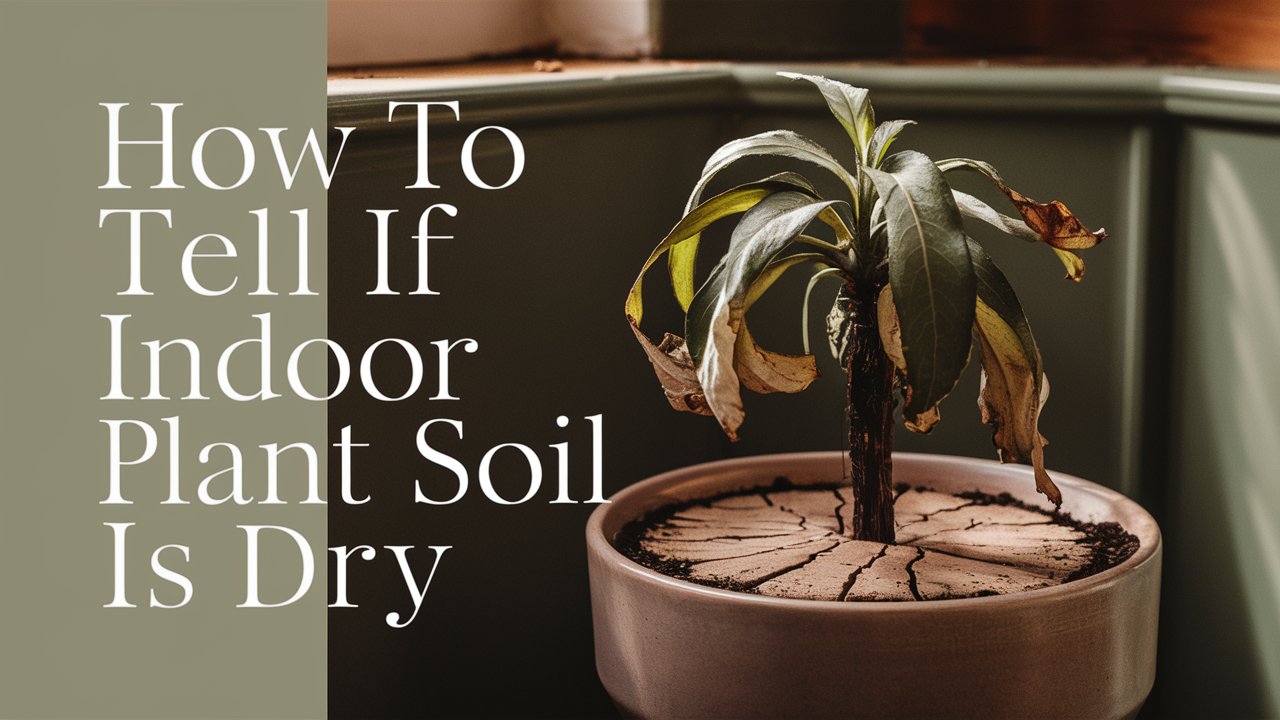Stick your finger an inch into the soil. If it feels dry, the soil needs watering.
Indoor plants require careful attention to thrive. One crucial aspect is soil moisture. Overwatering or underwatering can harm your plants. Regularly checking soil moisture ensures healthy growth. Besides the finger test, observe the soil’s color and texture. Dry soil appears lighter and feels crumbly.
Moist soil looks darker and feels compact. Some plants may need specific moisture levels. Invest in a moisture meter for precise readings. Proper watering habits prevent root rot and nutrient deficiencies. Remember, each plant type has unique water needs. Understanding these requirements promotes lush, vibrant indoor plants. Keep a consistent watering schedule to maintain optimal soil moisture.
The Importance Of Proper Watering
Proper watering is crucial for the health of indoor plants. It ensures they grow strong and stay healthy. Too much water or too little water can harm them. Knowing when the soil is dry helps you water correctly.
Signs Of Overwatering
Overwatering can be as harmful as underwatering. Here are the signs to look for:
- Yellow leaves
- Soft, mushy stems
- Mold on the soil surface
- Foul smell from the soil
- Brown, wilted leaves
Consequences Of Underwatering
Underwatering can also cause problems for your plants. Watch out for these signs:
- Dry, brittle leaves
- Slow growth
- Leaf drop
- Soil pulling away from the pot edges
- Brown leaf tips
Table: Comparing Overwatering And Underwatering
| Overwatering | Underwatering |
|---|---|
| Yellow leaves | Dry, brittle leaves |
| Mushy stems | Slow growth |
| Mold on soil | Leaf drop |
| Foul smell | Soil pulling away |
| Brown leaves | Brown leaf tips |

Credit: www.reddit.com
Understanding Soil Moisture
Knowing how to tell if indoor plant soil is dry is crucial. Soil moisture affects the health of your plants. It determines their growth and vitality. Understanding soil moisture helps you water your plants correctly. This section will guide you through the essentials.
Types Of Soil And Their Water Retention
Different soils hold water differently. Here are some common types:
- Clay Soil: Holds water well but can become waterlogged.
- Sandy Soil: Drains quickly, making it dry out faster.
- Loamy Soil: Retains moisture well and drains well.
Each type of soil has unique properties. Understanding these properties helps you manage soil moisture better.
How Soil Structure Affects Moisture Levels
Soil structure plays a key role in moisture levels. Good soil structure promotes healthy plant growth.
Here are some factors that affect soil structure:
- Particle Size: Smaller particles hold more water.
- Organic Matter: Increases water retention.
- Soil Compaction: Compacted soil holds less water.
Maintaining a balanced soil structure ensures adequate moisture. Proper soil structure helps your plants thrive.
Key Indicators Of Dry Soil
Understanding the key indicators of dry soil in indoor plants is crucial. Your plants’ health depends on it. Knowing these signs helps you water them properly.
Texture And Color Changes
Dry soil shows specific texture and color changes. The soil becomes light and crumbly when dry. It loses its dark, rich appearance. The color shifts from dark brown to light brown or gray.
Use your fingers to check the soil. If it feels loose and dusty, it is dry. Moist soil feels more compact and cool to touch.
Plant Symptoms To Watch For
Plants exhibit symptoms that indicate dry soil. Wilting leaves are a common sign. Leaves may turn yellow or brown. The plant’s growth may slow down.
Check the plant’s overall appearance. If the plant looks droopy, it needs water. Dry soil can also cause leaves to curl or become crispy.
Monitor the plant’s growth. Stunted growth often means the soil is too dry.
Pro Tips For Checking Soil Moisture
Keeping your indoor plants healthy requires proper soil moisture management. Knowing how to check soil moisture helps prevent overwatering and underwatering. Here are some pro tips for checking soil moisture that will keep your plants thriving.
The Finger Test
The Finger Test is a simple and effective method. Stick your finger into the soil about 1-2 inches deep. If the soil feels dry at that depth, it’s time to water. If it feels moist, wait a few days before checking again. This test helps you gauge moisture levels without any tools.
Using A Moisture Meter
A moisture meter is a handy tool for precise readings. Insert the probe into the soil. The meter will display the moisture level. Most meters have a scale from dry to wet. Aim for a reading in the “moist” range. This tool helps you avoid guessing and provides accurate information.
The Weight Method
The Weight Method involves lifting the plant pot to feel its weight. A dry pot feels lighter than a well-watered one. Over time, you’ll learn to distinguish between the two weights. This method is especially useful for large pots where other methods might be difficult.
| Method | Tools Needed | Ease of Use |
|---|---|---|
| The Finger Test | None | Very Easy |
| Using a Moisture Meter | Moisture Meter | Easy |
| The Weight Method | None | Moderate |
- Check soil moisture regularly to keep plants healthy.
- Use different methods to get accurate readings.
- Avoid overwatering and underwatering by monitoring soil moisture.
Watering Techniques For Healthy Soil
Keeping the soil of indoor plants healthy involves proper watering techniques. Watering correctly ensures that plants grow strong and vibrant. Below, we explore different watering methods to maintain healthy soil.
Deep Watering Vs. Light Watering
Deep watering means soaking the soil thoroughly. This encourages roots to grow deeper. Deep roots help plants stay healthy and stable.
Light watering involves sprinkling the soil surface. This method only wets the top layer. It can lead to shallow root growth, making plants weak.
| Deep Watering | Light Watering |
|---|---|
| Soaks soil thoroughly | Wets the top layer |
| Encourages deep root growth | Leads to shallow roots |
| Promotes strong, stable plants | Makes plants weak |
Best Times To Water Indoor Plants
The best time to water indoor plants is in the morning. This gives plants time to absorb water before the sun gets too hot.
Watering plants in the evening can also be effective. It allows water to soak in overnight. Avoid watering during midday heat. The water evaporates quickly, leaving soil dry.
- Morning: Best for water absorption
- Evening: Good for soaking overnight
- Midday: Not recommended
By following these watering techniques, you can ensure your indoor plant soil stays healthy and your plants thrive.

Credit: www.reddit.com
Maintaining Optimal Moisture Levels
Ensuring your indoor plants have the right moisture levels is crucial. Too much water can lead to root rot. Too little water can cause the plant to wilt. Knowing how to maintain optimal moisture levels helps your plants thrive.
Creating A Watering Schedule
Creating a watering schedule helps keep your plants healthy. Use a simple table like the one below:
| Plant Type | Watering Frequency |
|---|---|
| Succulents | Once a week |
| Fern | Twice a week |
| Spider Plant | Every five days |
Check the soil before watering. Stick your finger one inch into the soil. If it feels dry, it’s time to water.
Adjusting Watering Based On Seasons
Plants need different amounts of water based on the season. During summer, plants may need more water. In winter, they need less water. Here are some tips:
- Summer: Water more often, as the heat dries the soil quickly.
- Winter: Water less, as the plant’s growth slows down.
- Spring and Fall: Adjust watering as needed, based on temperature changes.
Always check the soil before watering. This helps avoid overwatering or underwatering.
Common Mistakes In Watering Indoor Plants
Watering indoor plants properly is crucial for their health. Many plant parents make mistakes that can harm their plants. Recognizing these mistakes can help your indoor jungle thrive.
Ignoring Pot Size And Type
The size and type of pot affect how soil dries. Smaller pots dry out faster than larger ones. Clay pots dry out quicker than plastic ones. Use the right pot for your plant’s needs. Check the soil often, especially in smaller or clay pots.
Overlooking Environmental Factors
Temperature and humidity impact soil moisture. Hot, dry rooms make soil dry faster. Cool, damp rooms keep soil wet longer. Place plants in the right spot for their needs. Also, consider airflow around your plants. Too much airflow can dry soil quickly.
| Factor | Effect on Soil |
|---|---|
| Temperature | High temperature dries soil faster. |
| Humidity | High humidity keeps soil wet longer. |
| Airflow | Excess airflow dries soil quickly. |
- High temperature? Check soil moisture more often.
- Low humidity? Water plants more frequently.
- High airflow? Monitor soil to prevent dryness.

Credit: m.youtube.com
Advanced Tools For Soil Moisture Management
Advanced tools for soil moisture management have revolutionized plant care. These tools help monitor and maintain the right moisture levels. They ensure your plants thrive without overwatering or underwatering. Let’s explore some of these advanced tools.
Smart Soil Sensors
Smart soil sensors are innovative gadgets for plant care. They measure soil moisture accurately. These sensors often connect to your smartphone. You get real-time updates on your plant’s moisture levels. Some models also measure temperature and light. This data helps you adjust your plant care routine.
Here are some benefits of using smart soil sensors:
- Accurate moisture readings
- Real-time updates
- Easy to use
- Additional data on temperature and light
Automated Watering Systems
Automated watering systems simplify plant care. These systems water your plants at set times. They often work with smart soil sensors. The system waters only when moisture levels are low. This ensures your plants get the right amount of water.
Advantages of automated watering systems include:
- Consistent watering schedule
- Prevents overwatering and underwatering
- Saves time
- Works with other smart devices
Using these advanced tools, you can maintain perfect soil moisture. Your plants will stay healthy and happy.
Frequently Asked Questions
How To Check If Plant Soil Is Dry?
Insert your finger into the soil up to the first knuckle. If it feels dry, water the plant. Use a moisture meter for precise measurement.
How To Tell When Indoor Plants Need Water?
Check soil moisture by inserting a finger 1-2 inches deep. Water when the topsoil feels dry. Observe drooping leaves.
How Dry Should Houseplant Soil Be?
Houseplant soil should be slightly dry on the surface but moist an inch below. Avoid letting it dry out completely.
How To Test Soil Moisture With A Finger?
Insert your finger 1-2 inches into the soil. If it feels dry, water the plant. If it feels moist, no watering is needed.
Conclusion
Checking soil moisture is essential for healthy indoor plants. Use your finger, a moisture meter, or observe plant behavior. Regular monitoring prevents overwatering and underwatering, ensuring vibrant growth. By understanding these signs, your indoor garden will thrive. Keep your plants happy by maintaining the right soil moisture balance.
Happy gardening!

My mission is to help you bring the beauty of nature indoors with expert advice, detailed plant care guides, and creative design ideas.




